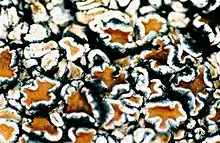Lecanorine lichen
A lichen has lecanorine fruiting body parts if they are shaped like a plate with a ring around them, and that ring is made of tissue similar to the main non-fruiting body part of the lichen.[1] The name comes from the name of the lichen genus Lecanora, whose members have such apothecia.[1] If a lichen has lecanorine apothecia, the lichen itself is sometimes described as being lecanorine.

The scrunched up apothecia discs of Lecanora muralis have rims that are made of tissue similar to the underlying body, so are said to be lecanorine.
References
- Field Guide to California Lichens, Stephen Sharnoff, Yale University Press, 2014, ISBN 978-0-300-19500-2, page 279
This article is issued from Wikipedia. The text is licensed under Creative Commons - Attribution - Sharealike. Additional terms may apply for the media files.